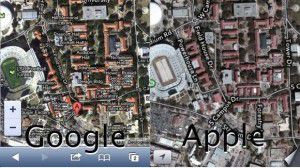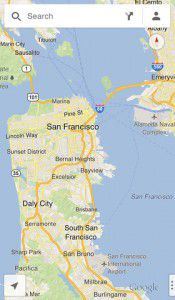F![]() act of the matter is Apple Maps is unreliable. It is unable to accurately navigate to locations. It is unable to find locations. It is unable to pinpoint locations. “No Results Found” is a common search result. It will often lead you to a location 2 or 3 blocks off. To me, this is a toy. Apple maps is not suitable for reliable use.
act of the matter is Apple Maps is unreliable. It is unable to accurately navigate to locations. It is unable to find locations. It is unable to pinpoint locations. “No Results Found” is a common search result. It will often lead you to a location 2 or 3 blocks off. To me, this is a toy. Apple maps is not suitable for reliable use.
Google Maps has found its way back to the iPhone.
The world’s most popular online mapping system returned late Wednesday with the release of the Google Maps iPhone app. The release comes nearly three months after Apple Inc. replaced Google Maps as the device’s built-in navigation system and inserted its own map software into the latest version of its mobile operating system.
Apple’s maps application proved to be far inferior to Google’s, turning what was supposed to be a setback for Google into a vindication.
The product’s shoddiness prompted Apple CEO Tim Cook to issue a rare public apology and recommend that iPhone owners consider using Google maps through a mobile Web browser or seek other alternatives until his company could fix the problems. Cook also replaced Scott Forstall, the executive in charge of Apple’s mobile operating system, after the company’s maps app became the subject of widespread ridicule.
Amo ng other things, Apple’s maps misplaced landmarks, overlooked towns and sometimes got people horribly lost. In one example brought to light this week, Australian police derided Apple’s maps as “life-threatening” because the system steered people looking for the city of Mildura into a sweltering, remote desert 44 miles from their desired destination.
ng other things, Apple’s maps misplaced landmarks, overlooked towns and sometimes got people horribly lost. In one example brought to light this week, Australian police derided Apple’s maps as “life-threatening” because the system steered people looking for the city of Mildura into a sweltering, remote desert 44 miles from their desired destination.
Google Inc., in contrast, is hailing its new iPhone app as a major improvement from the one evicted by Apple.
“We started from scratch,” said Daniel Graf, mobile director of Google Maps. Google engineers started working on the new app before Apple’s Sept. 19 ouster, Graf said, though he declined to be more specific.
to be more specific.
Digital maps are key battleground in mobile computing because they get used frequently on smartphones and can pinpoint a user’s whereabouts. That information is so prized by advertisers that they’re willing to pay much higher rates for marketing messages aimed at a prospective customer in a particular location, said Greg Sterling, an analyst at Opus Research.
Google’s mapping app for the iPhone doesn’t include ads, but that will likely change, based on the steady stream of marketing flowing through the Google maps app on Android phones.
The additional tools in the free iPhone app include turn-by-turn directions. Google’s previous refusal to include that popular feature on the iPhone app _while making it available for smartphones running on its own Android software_ is believed to be one of the reasons Apple decided to develop its own technology. The increasing friction between Google and Apple as they jostle for leadership in the smartphone market also played a role in the mapping switch. Just be happy that it is finally back and download they new software as fast as your internet connection allows you to!
Post some of your horror stories below in the comments on how bad apple maps has been!

I’d personally love to earn a site but.. I have no idea the type of blogs make the most targeted visitors? Exactly what blogs do you surfing? I actually generally surfing picture blogs and design blogs. Simply just having a poll below kudos!
Really nice style and superb written content, hardly anything else we need :D.
How do I get iPhone maps off my iPhone?